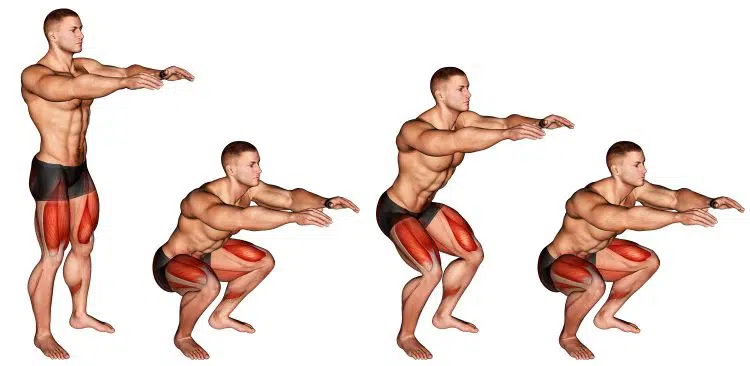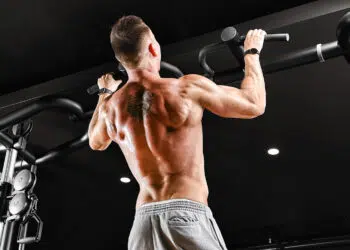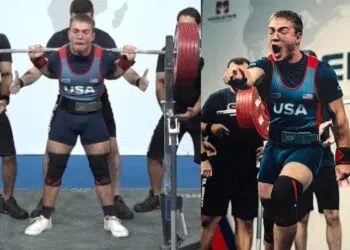Bodybuilders often say that if you want to grow, you’ve got to row. And while things like bent over, single-arm, Pendlay, Kroc, and T-bar rows are all important exercises, squats are even more important for muscle growth.
While squats are undeniably a leg exercise, they work various upper body muscles, too, especially when done with weights. Even bodyweight squats are useful and provide a great way to get in shape without workout equipment.
In this guide, we take a look at squat pulses, explaining why and how to do them, plus the best variations and alternatives.
Squat Pulses – Muscles Worked
Squat pulses are a compound exercise. That means, unlike isolation exercises like leg extensions and leg curls, they involve multiple muscle groups and joints working together.

The main muscles trained during squat pulses are:
Quadriceps
Known as your quads for short, this is where you’ll probably feel squat pulses the most. The quads consist of four muscles; vastus lateralis, vastus intermedius, vastus lateralis, and rectus femoris. They are responsible for extending your knees, and the rectus femoris is also a hip flexor.
Level Up Your Fitness: Join our 💪 strong community in Fitness Volt Newsletter. Get daily inspiration, expert-backed workouts, nutrition tips, the latest in strength sports, and the support you need to reach your goals. Subscribe for free!
Gluteus maximus
Located on the rear of your hip, gluteus maximus is also known as your glutes and is basically your butt. Its primary function is extending your hip.
Hamstrings
The three hamstring muscles are the biceps femoris, semimembranosus, and semitendinosus. They work together to extend your hips and flex your knees.
Abductors and adductors
Located on the inside and outside of your legs, respectively, these muscles prevent your knees from dropping in or out. The abductors are gluteus medius, gluteus minimus, and tensor fascia latae, while the adductors are longus, brevis, and magnus.
Core
The collective name for the muscles of your midsection, your core works to stabilize your spine during squat pulses. While unweighted squat pulses don’t involve a lot of core engagement, that all changes when you start using weights.
How to Do Squat Pulses
Get more from Squat Pulses while keeping your risk of injury to a minimum by following these guidelines:
- Stand with your feet shoulder-width apart, toes turned slightly outward. Brace your core and pull your shoulders down and back. Look straight ahead.
- Bend your legs and squat down until your thighs are roughly parallel to the floor. Take care not to round your lower back or let your knees drop in or fall out.
- Drive your feet into the floor and rise up a few inches. Descend back to parallel and repeat.
- Continue pulsing for the duration of your set, and then stand up to finish.
[Related: 12 Best Rowing Exercises To Build Muscle Mass]
Squat Pulse Benefits
Not convinced that squat pulse deserves a place in your workouts? Maybe we can convince you with these benefits!
No equipment required – with no weights, squat racks, or weightlifting belts needed, you can do squat pulses anywhere and anytime. They’re ideal for home workouts, and you can even pump out a set at work or your local park. Squat pulses are an excuse-free leg exercise.
Get a great pump – squat pulses are usually thought of as a conditioning or toning exercise. However, and especially done at the end of a workout, they could help you build muscle, too. With squat pulses, your muscles are under near-constant tension, which impedes blood flow, causes a big rise in lactic acid, and triggers a muscle-building pump. Make this exercise even better for building muscle by using blood flow restriction bands.
Knee joint-friendly – done correctly, squat pulses are a joint-friendly exercise. The small range of motion means your knees are not exposed to the same wear and tear as full depth squats. Providing you don’t a) go too deep or b) bounce instead of pulse, this exercise should be suitable for exercisers with less severe types of knee pain.
Squat Pulse Drawbacks
While squat pulses are a mostly beneficial exercise, there are also a few drawbacks to consider:
Limited overload – done with just your body weight, this move may not be challenging enough for stronger exercisers. The good news is that there are more demanding versions you can do instead.
Level Up Your Fitness: Join our 💪 strong community in Fitness Volt Newsletter. Get daily inspiration, expert-backed workouts, nutrition tips, the latest in strength sports, and the support you need to reach your goals. Subscribe for free!
Burning muscles – squat pulses are a semi-isometric exercise which means they have a small range of motion, with no lockout between reps. This causes a lot of lactic acid to accumulate in your muscles, and that’s gonna burn! While this sensation is undeniably uncomfortable, it won’t cause any long-term damage. However, when you do squat pulses, you’ll have to accept severe burning in your muscles.
10 Squat Pulse Variations and Alternatives
Squat pulses are a highly effective lower body exercise, but that doesn’t mean you need to do it all the time. There are several variations and alternatives you can use to keep your workouts productive and interesting:
1. Goblet squat pulse
If bodyweight squat pulses are no longer challenging enough, make them harder with a dumbbell or kettlebell. However, if you use a heavy weight, you may need to dump it on the deck at the end of your set rather than stand up with it. Place a mat on the floor in front of your feet to protect your flooring.
How to do it:
- Hold a dumbbell or kettlebell in front of your chest, just below your chin. Stand with your feet about shoulder-width apart. Brace your abs and pull your shoulders down and back.
- Squat down until your thighs are roughly parallel to the floor. Do not round your lower back.
- Rise up a few inches and then descend back to parallel. Continue for the prescribed number of reps, or until the burning in your muscles becomes intolerable!
Read more about goblet squats here.
2. Booty band squat pulse
Most people feel squat pulses in their quadriceps. Using a booty band increases abductor activation, so you’ll feel this variation more in your outer glutes and hips.
How to do it:
- Put a booty band around your legs, just above or below your knees. Stand with your feet shoulder-width apart, toes turned slightly outward. Brace your core and pull your shoulders down and back.
- Bend your legs and squat down until your thighs are roughly parallel to the floor.
- Rise up a few inches, descend back down to parallel, and repeat.
- Continue pulsing for the duration of your set, and then stand up to finish.
- You can also do this exercise using weights (exercise #1).
3. Plié squat pulse
Plié squats are a ballet-inspired exercise that involves squatting with a very wide stance. This increases adductor or inner thigh engagement. It’s also an excellent way to improve hip mobility. Doing plié squat pulses adds a new dimension to what was already a very beneficial exercise.
How to do it:
- Stand with your feet wider than shoulder-width apart. Turn your toes out to about 45 degrees. Your knees and toes should point in the same direction.
- Stand up tall, brace your abs, and look straight ahead.
- Keeping your torso upright, bend your legs, push your knees out, and descend until your thighs are roughly parallel to the floor.
- Rise up a few inches, descend back down to parallel, and repeat.
- Continue pulsing for the duration of your set, and then stand up to finish.
4. Wall sit
Where squat pulses involve a very small movement, wall sits involve no movement at all. See how long you can keep your thighs parallel to the floor. The official Guinness World Record is currently 11 hours, 51 minutes, and 14 seconds!
How to do it:
- Stand with your back to a smooth, strong wall, feet about 24 inches from the baseboard. Your feet should be between hip to shoulder-width apart.
- Lean your back against the wall and slide down until your thighs are roughly parallel to the floor. Your shins should be vertical. Maintain good posture throughout.
- Without resting your hands on your thighs, use your legs to push your back against the wall. Do not hold your breath, as doing so will cause your blood pressure to rise.
- You can push as hard as you can for a short time (10-20 seconds) or simply try and stay in position for as long as possible.
- On completion, either slide down the wall and sit on the floor to rest or use your hands on the wall to help you stand up.
5. Lunge pulse
If you’ve mastered squat pulses, give lunge pulses a try. When you do lunges, your weight is split roughly 60/40 in favor of your front leg.
This makes lunges a little more challenging than squats. Also, the balance demand is higher than for squats.
How to do it:
- Stand with your feet together and your arms by your sides. Brace your core and look straight ahead.
- Take a large step forward, bend your legs and lower your rear knee down to about an inch above the floor. Make sure your front shin and torso are upright.
- Rise up a few inches and then descend again.
- Keep pulsing for the duration of your set, and then stand back up. Rest a moment and repeat on the opposite side.
6. Squat pulse alternating with full squat
This variation increases time under tension and is a useful way to make both regular bodyweight squats and squat pulses more challenging.
How to do it:
- Stand with your feet shoulder-width apart, toes turned slightly outward. Brace your core and pull your shoulders down and back.
- Bend your legs and squat down until your thighs are roughly parallel to the floor. Rise up a few inches, descend back down to parallel.
- After pulsing once, stand all the way back up.
- Descend again, pulse, stand back up, and repeat.
- You can also do this exercise with weights (i.e., goblet squats) and/or a booty band.
7. Squat pulse jumps
If exercise #6 wasn’t challenging enough, try adding a jump between squat pulses. This will not only force your muscles to work harder but will also turn this move into a metabolic conditioning (metcon) exercise. Squat pulse jumps are high-impact and may not suit beginners, people with ankle, knee, or hip issues, or overweight exercisers.
How to do it:
- Stand with your feet shoulder-width apart, toes turned slightly outward. Brace your core and pull your shoulders down and back.
- Bend your legs and squat down until your thighs are roughly parallel to the floor. Rise up a few inches, descend back down to parallel.
- Next, and using your arms for extra momentum, leap up and into the air as high as you can.
- Land back in your squat stance, descend to parallel, pulse, and jump again.
8. Glute bridge pulse
Squat pulses are a useful lower body exercise that most people feel in their quads. As their name suggests, glute bridge pulses work your butt much more, making them a good alternative for or supplement to squat pulses.
How to do it:
- Lie on your back with your legs bent and feet flat. Brace your core.
- Drive your feet into the floor and lift your hips up, so your knees, hips, and shoulders form a straight line.
- Lower your hips a few inches and then push them back up again. Clench your butt at the top of each rep.
- Continue for the prescribed number of reps.
- Use a booty band to increase glute engagement.
9. Bulgarian split squat pulses
Bulgarian split squats, also known as rear foot elevated split squats, put even more weight on your front leg, so they’re an excellent way to increase the intensity of your workouts. You’ll also need better balance and hip mobility to do this exercise.
How to do it:
- Stand with your back to a knee-high bench or step. Bend one leg and place your foot on the top. Hop forward and into a split stance.
- Bend your legs and lower your rear knee down to within an inch of the floor.
- Drive your front foot into the floor and rise up a few inches. Descend back down and repeat.
- Continue for a predetermined number of reps, e.g., 20, or a set time, e.g., 30 seconds. Alternatively, keep going until the burn in your thighs becomes unbearable.
- Rest a moment, swap legs, and repeat.
10. Split squat pulses
When you do squat pulses, your weight is divided equally between your feet. Split squats put more weight on your front leg – roughly 60 percent. This makes them useful for increasing overload. Also, split squats help improve balance and hip mobility.
How to do it:
- Stand with your feet together, arms by your sides. Brace your core and pull your shoulders down and back.
- Take a large step forward and then stop.
- Bend your legs and lower your rear knee down to within an inch of the floor.
- Drive your front foot into the floor and rise up a few inches. Descend back down and repeat.
- Continue for a predetermined number of reps, e.g., 20, or a set time, e.g., 30 seconds. Alternatively, keep going until the burn in your thighs becomes unbearable.
- Rest a moment, swap legs, and repeat.
Squat Pulse – Wrapping Up
Squat pulses provide a great lower body workout, and you can do the basic version almost anywhere and anytime, as you don’t need any equipment. Contrary to their appearance, squat pulses are pretty challenging, and you’ll definitely feel your quads working after a few reps.
You can use squat pulses as part of a conditioning circuit or fat-loss HIIT, or as a pump-inducing finisher at the end of your bodybuilding leg workout. However you use them, squat pulses are a worthy addition to your lower body training.
Interested in measuring your progress? Check out our strength standards for Bulgarian Split Squat, Bodyweight Squat, T Bar Row, and more.











